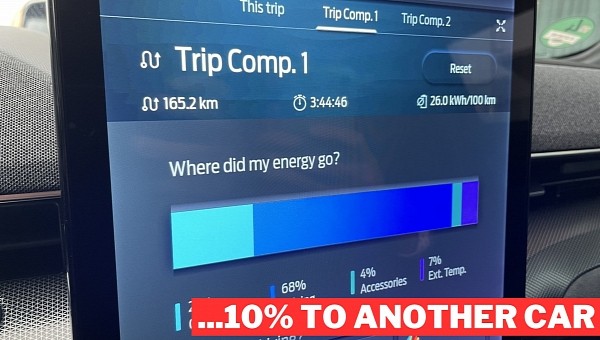Ford has come up with a new solution aimed at making range anxiety less of a shortcoming in the world of EVs.
The American carmaker has developed new technology that allows an EV to charge another zero-emission vehicle by relying on a system called “coordinated bi-directional charging for vehicles.”
If you’ve been following the latest developments in the technology world, you are probably familiar with how the system is supposed to work. Reverse charging powers wireless charging between devices like phones and tablets.
The feature makes sense particularly as the batteries installed in smartphones boast larger capacity, thus being able to provide some extra juice for other electronics.
Ford is trying to bring a similar approach to the automotive industry. However, the American carmaker is envisioning a more complex system whose main role would be handled by a charge transfer coordinator.
The charging process would allow a vehicle with a bi-directional charging-capable battery to provide power to a vehicle powered by a regular battery based on a series of instructions processed by the coordinator.
The system can be further enhanced with more advanced applications, such as controlling how much power the “charger” can provide to the second vehicle. In the case of phones, the charging process takes place wirelessly, but in Ford’s concept, the power transfer requires a cable for improved overall efficiency and faster charging rates.
In many ways, such a concept makes sense not only for electric vehicles built for mass adoption. Roadside assistance vehicles wouldn’t have to carry dedicated EV chargers anymore when equipped with this innovative battery. Larger battery packs that could be installed on these vehicles would allow them to provide fresh juice to an EV that ran out of power while driving. Both vehicles would then be capable of reaching a charging station without using extra equipment.
Ford’s system is ambitious, to say the least, especially as the automotive industry first needs to create a battery pack large enough to address range anxiety in the first place. Once this happens, carmakers can proceed with the next step and install batteries whose capacity allows for roadside assistance, eventually making driving an EV more convenient for everybody.
Ford’s technology continues to be in the patent phase, so bringing it to production models is unlikely to happen overnight. The company applied for the patent back in 2021, and it most likely continues the work on the tech as we speak.
Back in October 2022, a company called Zerova announced a 480kW charger that can work with up to four vehicles simultaneously. It can charge the battery in just 10 minutes and provide enough juice for 150 kilometers (90 miles) in no more, no less than five minutes.
If you’ve been following the latest developments in the technology world, you are probably familiar with how the system is supposed to work. Reverse charging powers wireless charging between devices like phones and tablets.
The feature makes sense particularly as the batteries installed in smartphones boast larger capacity, thus being able to provide some extra juice for other electronics.
Ford is trying to bring a similar approach to the automotive industry. However, the American carmaker is envisioning a more complex system whose main role would be handled by a charge transfer coordinator.
The charging process would allow a vehicle with a bi-directional charging-capable battery to provide power to a vehicle powered by a regular battery based on a series of instructions processed by the coordinator.
The system can be further enhanced with more advanced applications, such as controlling how much power the “charger” can provide to the second vehicle. In the case of phones, the charging process takes place wirelessly, but in Ford’s concept, the power transfer requires a cable for improved overall efficiency and faster charging rates.
In many ways, such a concept makes sense not only for electric vehicles built for mass adoption. Roadside assistance vehicles wouldn’t have to carry dedicated EV chargers anymore when equipped with this innovative battery. Larger battery packs that could be installed on these vehicles would allow them to provide fresh juice to an EV that ran out of power while driving. Both vehicles would then be capable of reaching a charging station without using extra equipment.
Ford’s system is ambitious, to say the least, especially as the automotive industry first needs to create a battery pack large enough to address range anxiety in the first place. Once this happens, carmakers can proceed with the next step and install batteries whose capacity allows for roadside assistance, eventually making driving an EV more convenient for everybody.
Ford’s technology continues to be in the patent phase, so bringing it to production models is unlikely to happen overnight. The company applied for the patent back in 2021, and it most likely continues the work on the tech as we speak.
Back in October 2022, a company called Zerova announced a 480kW charger that can work with up to four vehicles simultaneously. It can charge the battery in just 10 minutes and provide enough juice for 150 kilometers (90 miles) in no more, no less than five minutes.

















































